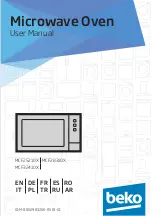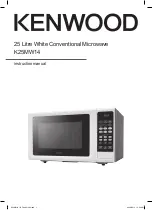
Tested for you in our cooking studio
en
41
Preserving
You can preserve fruit and vegetables using your
appliance.
:
Warning – Risk of injury!
If the food is preserved incorrectly, the preserving jars
may burst. Follow the instructions for preserving.
Jars
Only use clean and undamaged preserving jars. Only
use heat-resistant, clean and undamaged rubber rings.
Check clips and clamps in advance.
For each preserving process, only use preserving jars
that are the same size and contain the same food. In
the cooking compartment, you can preserve the
contents of a maximum of six
^
, 1 or 1
^
-litre
preserving jars at the same time. Do not use jars that
are larger or taller than this. The lids could rupture.
Preserving jars must not touch one another in the
cooking compartment during the preserving process.
Preparing fruit and vegetables
Only use fruit and vegetables that are in good condition.
Wash them thoroughly.
Peel, core and chop fruit and vegetables appropriate to
their type and fill the preserving jars with them up to
approx. 2 cm below the rim.
Fruit: Fill the preserving jars with the fruit along with a
hot, skimmed sugar solution (approx. 400 ml for a 1-
litre jar). For one litre of water:
■
Approx. 250 g sugar for sweet fruit
■
Approx. 500 g sugar for sour fruit
Vegetables: Fill the jars with the vegetables along with
hot, boiled water.
Wipe the rims of the jars, as they must be clean. Place
a damp rubber ring and a lid on each jar. Seal the jars
with the clips. Place the jars into the universal pan so
that they do not touch each other. Pour 500 ml hot
water (approx. 80 °C) into the universal pan. Use the
settings indicated in the table.
Ending the preserving process
Fruit: After a short while, small bubbles will form at short
intervals. Switch off the appliance once all preserving
jars are bubbling. Remove the jars from the cooking
compartment after the indicated residual heating time.
Vegetables: After a short while, small bubbles will form
at short intervals. As soon as all preserving jars are
bubbling, reduce the temperature to 120 °C and allow
the jars to continue to bubble in the closed cooking
compartment as indicated in the table. After this time
has elapsed, switch off the appliance and make use of
the residual heat for several minutes as indicated in the
table.
After preserving, remove the jars from the cooking
compartment and place them onto a clean cloth. Do not
place these hot jars onto a cold or damp surface, as
they may crack. Cover the preserving jars to protect
them from draughts. Only remove the clamps once the
jars are cold.
The indicated times in the settings table are average
values for preserving fruit and vegetables. They may be
influenced by room temperature, the number of jars,
quantity, heat and quality of the jar contents. The
specifications are based on 1-litre round jars. Before
you switch off the appliance or change the cooking
mode, check whether the contents of the jars are
bubbling as they should. The bubbling process starts
after approx. 30-60 minutes.
Meal
Accessory/cookware
Shelf
position
Heating
function
Step Tempera-
ture in °C
Cooking time in mins
Vegetables, e.g. carrots
1-litre preserving jars
1
:
1.
160-170
Before it starts bubbling: 30-40
2.
120
Once it starts bubbling: 30-40
3.
-
Residual heat: 30
Vegetables, e.g. cucumbers
1-litre preserving jars
1
:
1.
160-170
Before it starts bubbling: 30-40
2.
-
Residual heat: 30
Stone fruit, e.g. cherries, damsons
1-litre preserving jars
1
:
1.
160-170
Before it starts bubbling: 30-40
2.
-
Residual heat: 35
Pomes, e.g. apples, strawberries
1-litre preserving jars
1
:
1.
160-170
Before it starts bubbling: 30-40
2.
-
Residual heat: 25
Summary of Contents for HB.78.B series
Page 2: ......




































